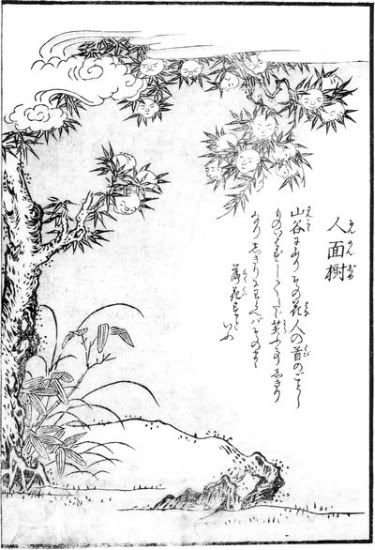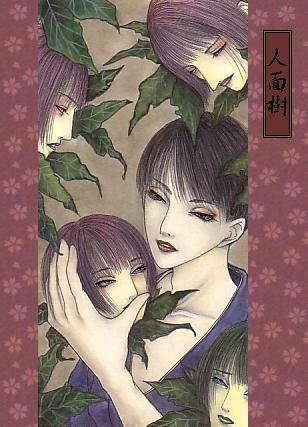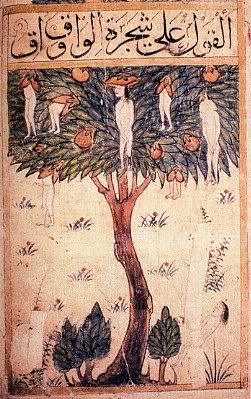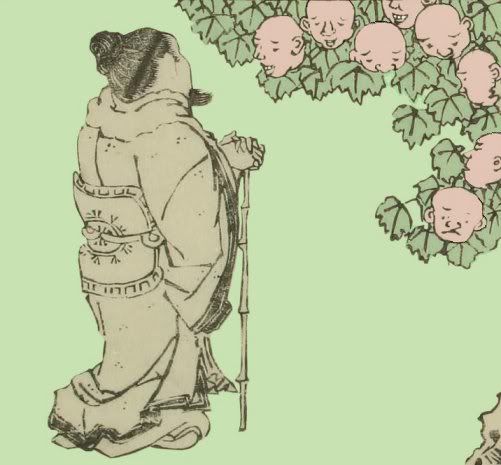mokuyoubi
Thursday
木 means "tree". So I'll tell you about one of the (many) tree yōkai. And while it is a yōkai, it is a very odd one, even by yōkai standards, as its story makes no sense. Also, it has to do with humans in its appearance, as well as the history of it. This thing's history deals with a great many humans, and also gives some interesting insight into Japanese folktales, so that's why I've chosen it for today.
『人面樹』
Jinmenju, or Ninmenju, "The Human-Faced Tree".
昔々・・・
One spring afternoon, a doctor was walking around in the forest, sightseeing. He reached a valley, the sun shining comfortingly amongst the trees there, and settled down to relax for a moment. He suddenly heard whispers, voices which seemed to come from everywhere, echoing around him.
"Who is there?" he called. The voices continued to chatter, unintelligible. "Who are you?"
"We are we." was his confusing reply. The doctor stood and whirled around, finally discovering something that seemed out of place amidst the valley trees. It was another tree, only this one was quite tall and seemed tropical. He walked toward it, where he could get a closer look at the pinkish-orange fruit hanging heavily from its branches, which looked sweet and delicious.
"Is someone behind that tree?"
"We are the tree." The fruit turned itself toward him, and he saw that each one possessed a tiny human face, with eyes, mouth, and teeth, as well as ears and a nose, too. It seemed for everything that there were dozens of babies' heads dangling from the tree branches. The tiny eyes all focused on him, and they spoke as one, with one voice, a child's haunting seriousness. "We are the tree." it said again.

Sekien's Jinmenju.
The doctor screamed and stumbled back. He tripped over a rock and went sprawling.
The tiny fruits seemed to shriek with laughter at the doctor's clumsiness. They laughed, swinging on their branches, until the force of their giggling broke the branches and sent them tumbling to the ground. The fruit began to shout, "No! No!", and as they hit the ground, they rolled and frowned.
What a strange encounter that doctor had!
The End
So there's your traditional Japanese tale. Though I did embellish the story a bit, and stop short of giving you the doctor's entire medical history and key moments in his career. But that's not where the story of the Jinmenju ends. Or rather, begins. The history of the Jinmenju story is perhaps just as interesting as the odd fable itself.
The image of the human-faced tree is a popular one in many stories and all sorts of media in Japan. It's a very popular subject.

Astute readers may recognise a potential predecessor of the Jinmenju story. If you've read Journey to the West, you may remember a similar tree. In fact, early versions of Japan's Jinmenju story say that the doctor was Chinese, or was visiting China, or that these trees grow in Chinese valleys. In Journey to the West, Sun Wukong finds himself in the company of a peach tree with fruit that resembles human babies, which is enjoyed by the Immortals. In fact, the tree contributes to their immortality. The fruit takes several thousand years to grow, and then several thousand more to become large enough to eat, and then several thousand more to be edible. It is then that the Immortals gather and hold a Peach Feast and eat the fruits, which in turn extend their life by many more thousand years.
It is said that humans will rarely eat them, because it seems too much like eating a baby, however in some tales, after the fruit has laughed at someone and fallen to the ground, our hero will go on to take a bite of them, for whatever reason, and reports that the taste is sweet and crunchy like a citrus fruit. So apparently someone who passed this story along had gotten over his fear of cannibalism, and eaten the immortal peach before.
Earlier still is a record found in an old Japanese encyclopaedia, catalogued by a doctor (perhaps why the story I heard involved a doctor?), which says that, no, they are not found in China, but on a mysterious island somewhere in the Indian Ocean.
Scholars have pointed out that this is also vaguely referenced in the Middle Eastern fairy tale book, One Thousand and One Nights, in which an island called Waq-Waq has a strange tropical tree growing on it, which bears fruit in the shape of fully grown humans.

Whatever the origin, the Jinmenju certainly is strange and pretty creepy as an idea. It's generally thought that One Thousand and One Nights inspired the story of Jinmenju, or else a different Persian folktale which came to China, which was then translated and re-imagined by Japanese during 100 Ghost Story Night. But it's very interesting to me to see a yōkai with such a foreign origin. The Jinmenju certainly has some long and strange roots!

So i guess this means that Yokai don't necessarily have to be of Japanese origin.
ReplyDeleteThat's right! Several yōkai were adapted from Chinese or Ainu stories that were translated into Japanese. Though one possibly taken from a Persian fairy tale is pretty strange, even by yōkai standards.
ReplyDelete